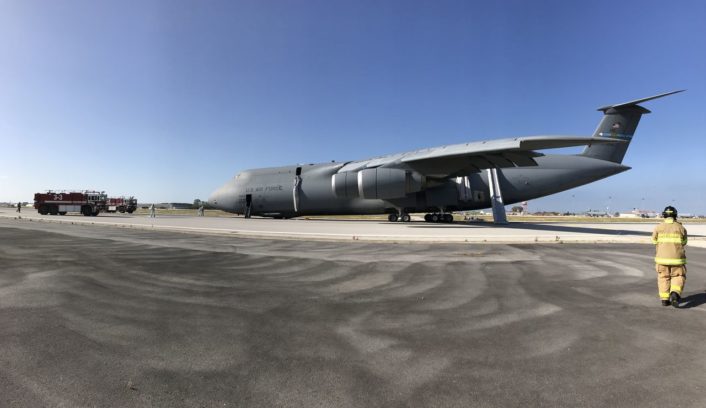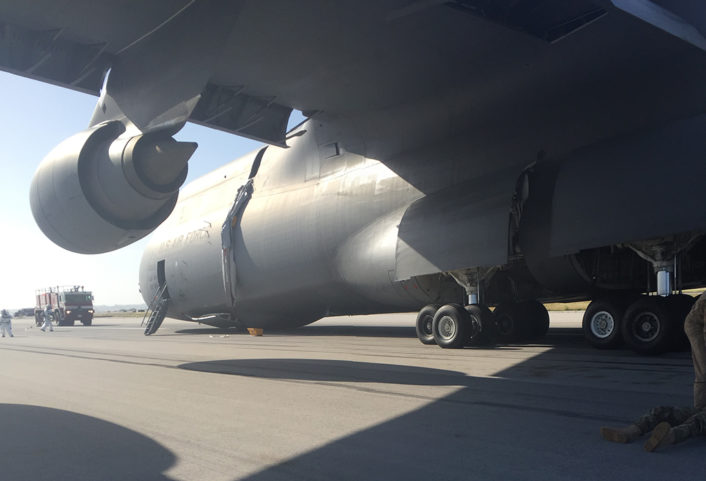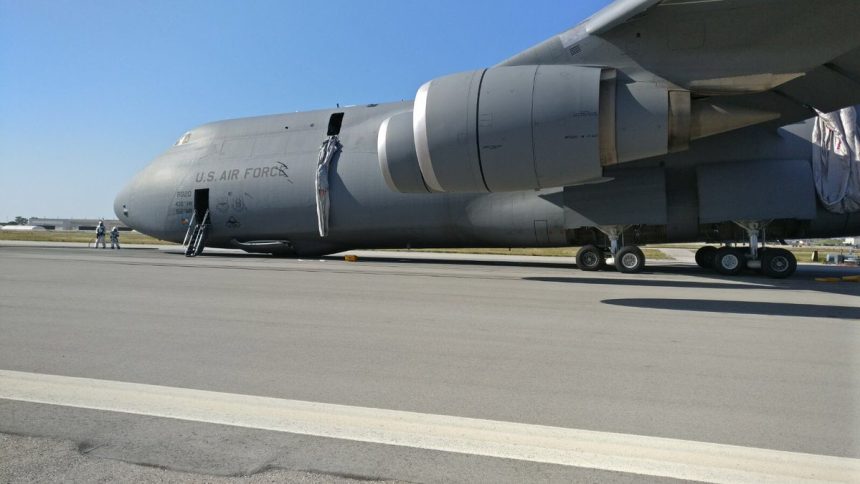A USAF C-5 Galaxy airlifter has made a successful emergency landing in Spain.
The top image was reportedly taken yesterday at Rota Air Base, Spain.
Sent us by one of our Twitter followers (thank you @asetanton), it shows a U.S. Air Force C-5M Galaxy cargo aircraft, registration 86-0020, that was forced to perform a nose gear up landing at the Spanish airbase after experiencing an unknown failure that made it unable to extend its nose landing gear.
We have just received a photograph from Rota:

According to a source who wishes to remain anonymous, while on approach into Rota, as well extending the gear, the nose gear showed a “red wheels” indication. This told the crew that the gear doors were open but the gear didn’t move.
One of the Engineers ran downstairs to the fiber optic scope that is used in these cases to verify the gears position. The check proved that the nose gear was still up in the gearwell.
After that the aircrew ran the emergency extension procedures. One was to use the emergency extension switch located on the flight deck, and the other was actuating the hydraulic valves on their own.
The crew members tried these procedures in holding for over an hour where they finally had to turn back for Rota as they had reached the bingo fuel. The aircrew attempted to normally cycle the gear numerous times and they eventually got the landing gear to extend roughly 6 inches.
On the way in they ran the “wheels up, crash landing” checklist which included the nose gear up provisions. The provisions have the crew keep the gear up and the doors closed to minimize damage (as seen by the other times this procedure has been run). However, with the gear stuck partially extended, this became impossible. But with luck the wheels were far enough out that the Galaxy actually only experienced visual damage equal to what a wheel on a car looks like after it scraps a curb. After the plane came to a complete stop, the aircrew evacuated the flight deck and then assisted the evacuation of the 21 passengers in the troop compartment.

Here’s a clip showing the Galaxy as it approaches Rota for the gear up landing:
@asetanton @combataircraft @TheAviationist pic.twitter.com/N3vR7gjQma
— Aset Anton (@asetanton) May 23, 2017
The C-5 Galaxy’s nose gear is part of a unique tricycle-type landing gear system consisting of a total of 28 wheels.
It is a fine piece of machinery made of four main units fitted in tandem pairs, each with a six-wheel bogie with two forward and four rear wheels: the MLG (Main Landing Gear) rotates 90 degrees horizontally to be accommodated inside the gear bays when retracted after take off; furthermore, it is steerable for a 20 degrees left or right for crosswind landings.
Anyway, this was not the first time a Galaxy performed an emergency landing without an extended nose gear. You can find in the Internet at least a couple of videos of such gear up incidents.
The first dates back to August 1986, when a C-5A performed a nose gear up landing at Rhein Main Air Base, Germany:
According to the user who posted it on Vimeo, since Rhein Main shared the runway with the Frankfurt airport, and this gear up landing shut down the airport for at least a couple of hours.
The second incident occurred in May 2001 (we already posted a short story about it here), when a C-5 from Travis Air Force Base diverted to Rogers Dry Lake to perform a successful landing after the nose gear failed.
Top image via @asetanton







